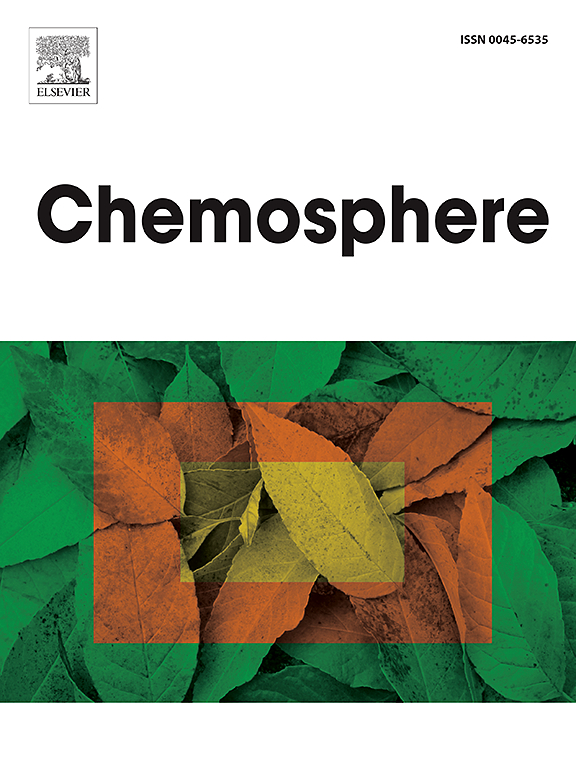Examining the impact of hydroxy group position on antibacterial activity of copper complexes derived from vanillin-based Schiff bases: Experimental and computational analysis
IF 8.1
2区 环境科学与生态学
Q1 ENVIRONMENTAL SCIENCES
引用次数: 0
Abstract
The positioning of the hydroxy group plays a crucial role in the coordination of Schiff bases with copper ions and their antibacterial effectiveness. This potential is an area of interest for future exploration, although no specific studies have been conducted. This study aims to reveal the significance of the positioning of the hydroxy group in the ability of the Schiff base to coordinate with copper ion and its antibacterial efficacy against E. coli and S. aureus. By utilizing ortho-vanillin and para-vanillin as precursors, we successfully synthesized Schiff bases HL1 (ortho) and L2 (para), which were confirmed through Fourier Transform Infrared (FT-IR) and Nuclear Magnetic Resonance (NMR) analyses. HL1 forms the CuL1 complex as a bidentate ligand with N, O donor atoms, while L2 only provides a single N donor atom, forming the CuL2 complex but retaining a free hydroxy group. Crystallographic analysis revealed a tetragonal crystal system for the Schiff base and orthorhombic for the complex. Electronic transition analysis supported by Density Functional Theory (DFT) studies indicated a distorted square plane geometry for the CuL1 and CuL2 complexes. The in vitro antibacterial assessment against E. coli and S. aureus revealed that the CuL1 and CuL2 complexes exhibited significantly better activity than Schiff bases HL1 and L2. Moreover, CuL2 exhibits greater bioactivity against both bacterial strains compared to CuL1. This difference could be attributed to a free hydroxy group, supported by computational analysis. Our findings suggest that the formation of complexes and the presence of free hydroxy groups may enhance the antibacterial activity of the drug.

研究羟基位置对香兰素基席夫碱铜配合物抗菌活性的影响:实验和计算分析。
羟基的定位对席夫碱与铜离子的配位及其抗菌效果起着至关重要的作用。这一潜力是未来勘探的兴趣领域,尽管尚未进行具体研究。本研究旨在揭示羟基在希夫碱与铜离子配合能力中的定位及其对大肠杆菌和金黄色葡萄球菌的抑菌作用。以邻香兰素和副香兰素为前体,成功合成了希夫碱HL1(邻位)和L2(对位),并通过傅里叶变换红外(FT-IR)和核磁共振(NMR)分析证实。HL1以双齿配体的形式与N, O给体原子形成CuL1配合物,而L2仅提供单个N给体原子,形成CuL2配合物,但保留了一个自由羟基。晶体学分析表明,希夫碱为四方晶系,配合物为正交晶系。密度泛函理论(DFT)支持的电子跃迁分析表明,CuL1和CuL2配合物具有扭曲的方形平面几何形状。体外对大肠杆菌和金黄色葡萄球菌的抑菌实验表明,CuL1和CuL2复合物的抑菌活性明显优于希夫碱HL1和L2。此外,与CuL1相比,CuL2对这两种细菌都表现出更大的生物活性。这种差异可以归因于一个自由羟基,由计算分析支持。我们的研究结果表明,配合物的形成和游离羟基的存在可能会增强药物的抗菌活性。
本文章由计算机程序翻译,如有差异,请以英文原文为准。
求助全文
约1分钟内获得全文
求助全文
来源期刊

Chemosphere
环境科学-环境科学
CiteScore
15.80
自引率
8.00%
发文量
4975
审稿时长
3.4 months
期刊介绍:
Chemosphere, being an international multidisciplinary journal, is dedicated to publishing original communications and review articles on chemicals in the environment. The scope covers a wide range of topics, including the identification, quantification, behavior, fate, toxicology, treatment, and remediation of chemicals in the bio-, hydro-, litho-, and atmosphere, ensuring the broad dissemination of research in this field.
 求助内容:
求助内容: 应助结果提醒方式:
应助结果提醒方式:


